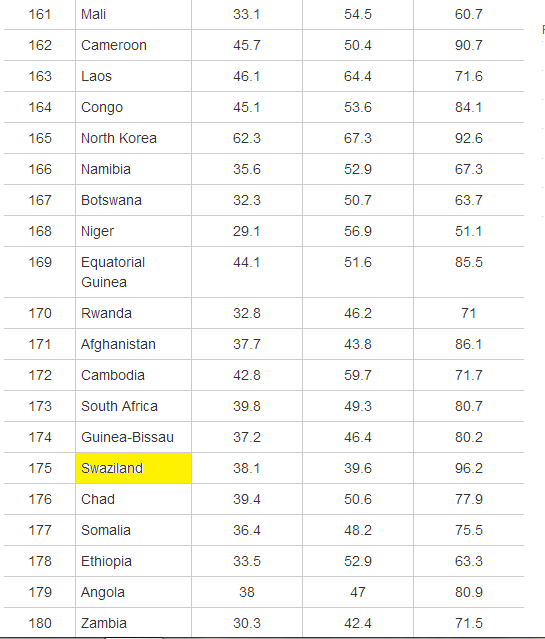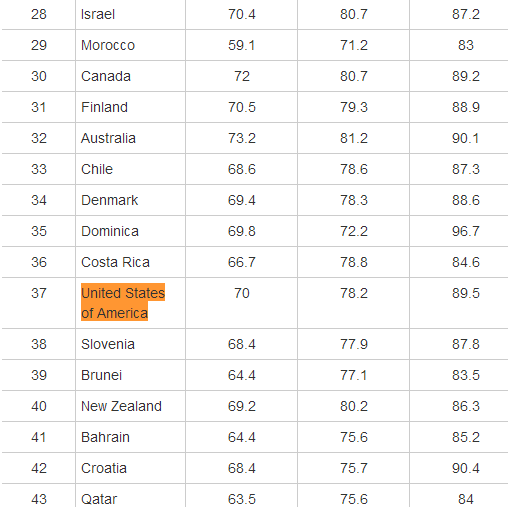In the western world, in modern times, life expectancy is higher than it was in the past and higher than it currently is in the third world. But is that entirely a good thing? Most people think that it is, but many of us may be misinterpreting the statistics, myself included.
One of things you have to be very careful about is who is being counted when the statistics are compiled. For instance, when we read that the average life expectancy in Swaziland is 39.6 years and the average life expectancy in the United States is 78.2, we might think that living in the United States is much better. By the same token, if we hear that life expectancy in the United States a century ago was around forty years and today is closer to eighty years, we might think that we have made great strides forward due to modern medicine and our current lifestyle.
In the table below, the first number represents healthy average life expectancy and the second one represents actual average life expectancy and the third figure is the percentage of life expectancy that is healthy.

Swaziland has a high healthy life expectancy but a low absolute life expectancy
Source: http://ngureco.hubpages.com/hub/Worlds-Best-Health-Care-Ranking-of-Health-Care-by-Countries-and-Healthy-Life-Expectancy-by-Country
But there are two factors to be considered that we usually forget to consider:
- How does absolute life expectancy compare to healthy life expectancy?
- Who was counted as a person for purposes of the calculation of absolute life expectancy?
According to the chart I posted above, the average person in Swaziland could expect to die at 39.6 years of age, but he would be perfectly healthy, without experiencing any sort of illness until he turned 38.1. That means that for about 96 percent of his life, a person in Swaziland would have no health issues. If having a healthy population is your goal, that seems to be the best country in the world to live in.
But wait, who wants to die so young? Wouldn’t it be better to experience more health difficulties, and even undergo surgery or become dependent on drugs, if that will nearly double your lifespan?
In the chart below we see that in the United States the average person could expect to live a healthy life until age seventy, after which he might continue to live an unhealthy life until he was about seventy-eight years old. While those last eight years might be excruciatingly painful and involve several surgeries and being on drugs and a reduction of quality of life, still seventy years of healthy life sounds pretty good, compared to thirty-nine in Swaziland.

American Healthy Average Life Expectancy is 70, after which Americans get to be sick for another eight years before they die
But what if we have entirely misinterpreted those numbers, based on not thinking about what “average” means, and who is being counted as a person for purposes of the average?
I believe that for purposes of these statistics, a newborn baby counts as a person. Now, when you realize how high infant mortality is in undeveloped countries, and how high the birth rate actually is, then it changes the picture completely. Instead of imagining the average adult only getting to live to be thirty-nine, we can imagine that for every adult who makes it to seventy in Swaziland, there might have been a baby who died before age eight. Totally different picture! It means that it’s tough to be an infant or child in that country, but the benefits of surviving are a long and healthy life.
There is a story they tell about the photographer Leni Riefenstahl. After she realized that she had been wrong to support Hitler, she tried to make up for her previous actions by going to Africa and photographing native populations in all their diversity and beauty. But people still accused her of being a fascist. “All the people you photographed were beautiful and healthy!” they said to her. “Why didn’t you take pictures of any ugly or sick people?” She answered: “I didn’t see any ugly or sick people. All the people I saw were beautiful and healthy.” I don’t know if this story is true, but I did read it somewhere. It made me think.
What if in the United States, we are not lengthening our lifespan by a single year with our modern medicine? What if the average adult person has always lived to be about seventy? What if by reducing our birth rate and our infant mortality, we have simply changed the way we count people? We don’t count all the people who would have been born, but haven’t been. And we don’t let our newborns die, no matter how sick they are. That doesn’t make for a healthier population or a longer life. But it does increase the percentage of the economy that is dedicated to healthcare.
I’m not saying this is necessarily the case. My calculations about Swaziland were entirely speculative. I don’t actually know how high their infant and child mortality are. Nor do I know to what extent American reduction of infant mortality has led to the average lifespan going up from the previous century. I’m just saying that we need to look into average life expectancy more closely and ask ourselves who is being counted for the purposes of these calculations, because the figures could be doctored in order to convince most voting adults today that they need healthcare in order to live a long life.
RELATED ARTICLES
http://aya-katz.hubpages.com/hub/What-is-Immortality-and-How-Can-I-get-Some
http://aya-katz.hubpages.com/hub/The-Role-of-Death-in-Life

I would not want to live in an era when plague was rampant, but as you point out, we have some problems in our modern era as well. I sometimes feel we would all be healthier without the prescription medications that are foisted upon us, but this is not a popular thing to say. On my twitter feed I noticed many people talking about depression, and medications they openly take for this. A hundred years ago people did not openly talk about depression, and I often wonder how the industry likes to emphasize the needs to take medication for this issue to make money. I know that is a different issue, but I think the psychology community likes to make a penny off people feeling they need these things, whereas people who were explorers and adventurers were out living life. They did not write about being immobilized by depression. Not trying to belittle it, but I feel it is inflated in today’s realm for big pharma needs.
Hi, Julia. I agree with what you said. It may even be that because we have less room to explore and most people spend less time outdoors that more and more people feel deeply depressed. So I am not belittling how people feel — there may be a very good reason for those feelings — but the answer is not more drugs.